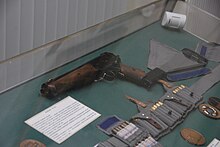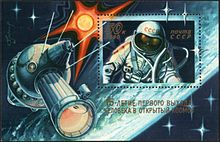Voskhod 2
The Vostok-based Voskhod 3KD spacecraft with two crew members on board, Pavel Belyayev and Alexei Leonov, was equipped with an inflatable airlock.
It established another milestone in space exploration when Alexei Leonov became the first person to leave the spacecraft in a specialised spacesuit to conduct a 12-minute spacewalk.
Cosmonaut Leonov's spacewalk lasted 12 minutes and 9 seconds (08:34:51–08:47:00 GMT), beginning over north-central Africa (northern Sudan/southern Egypt), and ending over eastern Siberia.
[6] After his 12 minutes and 9 seconds outside the Voskhod, Leonov found that his suit had stiffened, due to ballooning out, to the point where he could not re-enter the airlock.
The two crew members subsequently experienced difficulty in sealing the hatch properly due to thermal distortion caused by Leonov's lengthy troubles returning to the craft, followed by a troublesome re-entry in which malfunction of the automatic landing system forced the use of its manual backup.
Although flight controllers had no idea where the spacecraft had landed or whether Leonov and Belyayev had survived, the cosmonauts' families were told that they were resting after having been recovered.
Even worse, the electrical system completely malfunctioned so that the heater would not work, but the fans ran at full blast.
After a more comfortable second night in the forest, the cosmonauts skied to a waiting helicopter several kilometers away and flew first to Perm, then to Baikonur for their mission debriefing.
[7]: 457–459 [8] General Nikolai Kamanin's diary later gave the landing location of the Voskhod 2, about 75 kilometres (47 miles) from Perm in the Ural mountains in heavy forest at 59°34′N 55°28′E / 59.567°N 55.467°E / 59.567; 55.467 on 19 March 1965 09:02 GMT.
Initially, there was some confusion and it was believed that Voskhod 2 landed not far from Shchuchin (about 30 kilometres or 19 miles south-west of Bereznikov, north of Perm), but no indication was received from the spacecraft.
[11] Apparently a commander of one of the search helicopters reported finding Voskhod 2, "On the forest road between the villages of Sorokovaya and Shchuchino, about 30 kilometers southwest of the town of Berezniki, I see the red parachute and the two cosmonauts.
The airlock was necessary for two reasons: first, the capsule's avionics used vacuum tubes, which required a constant atmosphere for air cooling.
Also, supplies of nitrogen and oxygen sufficient to replenish the atmosphere after EVA could not be carried due to the spacecraft's weight limit.
By contrast, the American Gemini capsule used solid state avionics, and an atmosphere of oxygen only, at a pressure of 69 kPa (10.0 psi), which could easily be replenished after EVA.
He later said the umbilicus gave him tight control of his movements — an observation purportedly belied by subsequent American spacewalk experience.
Sergei Korolev, Chief Designer at OKB-1 Design Bureau (now RKK Energia), stated after the EVA that Leonov could have remained outside for much longer than he did, while Mstislav Keldysh, "chief theoretician" of the Soviet space program and President of the Soviet Academy of Sciences, said that the EVA showed that future cosmonauts would find work in space easy.
He could not take pictures of Voskhod 2, but was able to recover the camera mounted on Volga which recorded his EVA for posterity but only after it stuck and he had to exert considerable effort to push it down in front of him.
[20] Also, the two cosmonauts had experience that would aid them in this situation: Belyayev grew up in Chelishchevo with the dream of becoming a hunter, while Leonov had spent time in the wilderness alone as an artistic outlet.
[21] After spending two cold nights in a dense forest, Leonov and Belyayev were able to ski 9 kilometres (5.6 mi; 4.9 nmi) with the help of some rescuers to reach the helicopters landing site.



